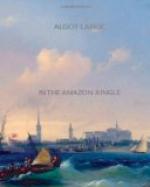It seems strange that during my stay among the Mangeromas, who were heathens and even cannibals, I saw no signs of idolatry. They believed implicitly in a good and an evil spirit. The good spirit was too good to do them any harm and consequently they did not bother with him; but the evil spirit was more active and could be heard in the dark nights, howling and wailing far off in the forest as he searched for lonely wanderers, whom he was said to devour.
Thinking to amuse some of my friends, I one day kindled a flame by means of my magnifying glass and a few dry twigs. A group of ten or twelve Indians had gathered squatting in a circle about me, to see the wonder that I was to exhibit, but at the sight of smoke followed by flame they were badly scared and ran for the house, where they called the Chief. He arrived on the scene with his usual smile.
He asked me to show him what I had done. I applied the focussed rays of the sun to some more dry leaves and twigs and, finally, the flames broke out again. The Chief was delighted and begged me to make him a present of the magnifier. As I did not dare to refuse, I showed him how to use it and then presented it with as good grace as I could.
Some time after this, I learned that two Peruvians had been caught in a trap set for the purpose. The unfortunate men had spent a whole night in a pit, nine feet deep, and were discovered the next forenoon by a party of hunters, who immediately killed them with unpoisoned, big-game arrows. In contrast to the North-American Indians they never torture captives, but kill them as quickly as possible.
I had plenty of opportunity to investigate the different kinds of traps used by the Mangeromas for catching Peruvian caboclos or half-breeds. First of all in importance is the pit-trap, into which the aforesaid men had fallen. It is simple but ingenious in its arrangement. A hole about nine feet deep and eight feet wide is dug in the ground at a place where the caboclos are liable to come. A cover is laid across this and cleverly disguised with dead leaves and branches so as to exactly resemble the surrounding soil. This cover is constructed of branches placed parallel, and is slightly smaller than the diameter of the pit. It is balanced on a stick, tied across the middle in such a manner that the slightest weight on any part will cause it to turn over and precipitate the object into the pit whence egress is impossible. Besides this, the walls of the pit are inclined, the widest part being at the bottom, and they gradually slope inward till the level of the ground is reached. When the victim is discovered he is quickly killed, as in the case noted above.
The second trap, which I had an opportunity to investigate, is the so-called araya trap. It is merely a small piece of ground thickly set with the barbed bones of the sting-ray. These bones are slightly touched with wourahli poison and, concealed as they are under dead leaves, they inflict severe wounds on the bare feet of the caboclos, and death follows within a short period.




